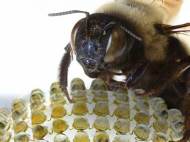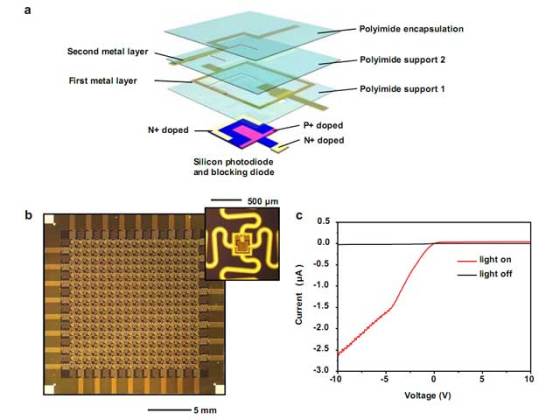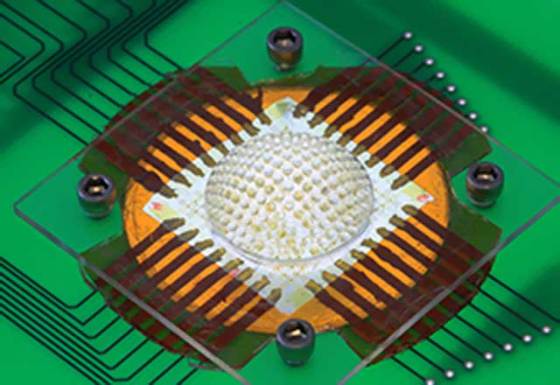Arthropod eye design inspires novel digital cameras
 Inspired by eyes found in arthropods, an interdisciplinary and international team of researchers has created a digital camera with designs that mimic the ocular systems found in dragonflies, bees, praying mantises and other insects. The device could be used in surveillance devices, tools for endoscopy, and other applications where these insect-inspired designs provide unique capabilities.
Inspired by eyes found in arthropods, an interdisciplinary and international team of researchers has created a digital camera with designs that mimic the ocular systems found in dragonflies, bees, praying mantises and other insects. The device could be used in surveillance devices, tools for endoscopy, and other applications where these insect-inspired designs provide unique capabilities.
Eyes in arthropods use compound designs, in which arrays of smaller eyes act together to provide image perception. Each small eye, known as an ommatidium, consists of a corneal lens, a crystalline cone, and a light sensitive organ at the base. The entire system is configured to provide exceptional properties in imaging, many of which lie beyond the reach of existing man-made cameras.
The devices combine soft, rubbery optics with high performance silicon electronics and detectors, using ideas first established in research on skin and brain monitoring systems by John A. Rogers, a Swanlund Chair Professor at the University of Illinois at Urbana-Champaign, and his collaborators.
“Full 180 degree fields of view with zero aberrations can only be accomplished with image sensors that adopt hemispherical layouts – much different than the planar CCD chips found in commercial cameras”, said Rogers. “When implemented with large arrays of microlenses, each of which couples to an individual photodiode, this type of hemispherical design provides unmatched field of view and other powerful capabilities in imaging. Nature has developed and refined these concepts over the course of billions of years of evolution.”
Fabrication method
The fabrication starts with electronics, detectors and lens arrays formed on flat surfaces using advanced techniques adapted from the semiconductor industry. The lens sheet is made from a polymer material similar to a contact lens—and the electronics/detectors are then aligned and bonded together. Pneumatic pressure deforms the resulting system into the desired hemispherical shape, in a process much like blowing up a balloon, but with precision engineering control.
“A critical feature of our fly’s eye cameras is that they incorporate integrated microlenses, photodetectors, and electronics on hemispherically curved surfaces”, said Jianliang Xiao, an assistant professor of mechanical engineering at University of Colorado Boulder. “To realize this outcome, we used soft, rubbery optics bonded to detectors/electronics in mesh layouts that can be stretched and deformed, reversibly and without damage.”
The individual electronic detectors and microlenses are coupled together to avoid any relative motion during this deformation process. Here, the spaces between these artificial ommatidia can stretch to allow transformation in geometry from planar to hemispherical. The electrical interconnections are thin, and narrow, in filamentary serpentine shapes which deform as tiny springs during the stretching process.
Operation of insect-inspired arrays of microlenses
Each microlens produces a small image of an object with a form dictated by the parameters of the lens and the viewing angle. An individual detector responds only if a portion of the image formed by the associated microlens overlaps the active area. The detectors stimulated in this way produce a sampled image of the object that can then be reconstructed using models of the optics.
The device is almost fully hemispherical and features 180 imaging elements, providing a 160-degree field of view. The camera combines elastomeric compound optical elements with deformable arrays of thin-film silicon photodetectors, in co-integrated sheets that can be molded into hemispherical shapes.
“What we have, in a sense, is many small eyes on one big eye,” said Northwestern’s Yonggang Huang, Joseph Cummings Professor of Civil and Environmental Engineering and Mechanical Engineering at the McCormick School of Engineering and Applied Science. “Each small eye, composed of a microlens and a microscale photodetector, is a separate imaging system, but when they are all taken together, the camera can take a clear picture, with just one snap, of nearly 180 degrees. The interface of different fields generates interesting new devices that never existed before.”
For more information, read the paper published in Nature: “Digital cameras with designs inspired by the arthropod eye”.











are there planar arthropod inspired imaging system?